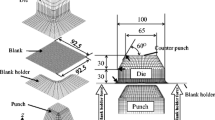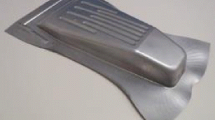Abstract
Both blank shape minimizing earing and blank holder force (BHF) have an influence on the product quality as well as product cost. Recently, variable blank holder force (VBHF) that the BHF varies through the punch stroke is an attractive approach for improving the product quality as well. This paper proposes a method to simultaneously determine both optimal blank shape minimizing earing and the optimal VBHF trajectory for a cylindrical cup deep drawing. In this paper, the earing is separately evaluated as (1) the area above the trimmed line, and (2) the area below the trimmed line, and both are then minimized. The distance between the trimmed line and the cup height is also considered in the objective functions for the flatness of earing. Therefore, a multi-objective optimization problem is formulated. Numerical simulation in sheet metal forming is so numerically intensive that response surface approach is used. In particular, a sequential approximate optimization (SAO) using a radial basis function (RBF) network is used to determine the optimal blank shape and VBHF trajectory. In the numerical simulation, a cylindrical cup deep drawing based on NUMISHEET 2011(BM1) is considered, and the validity of the proposed approach is examined.
Similar content being viewed by others
References
Neto DM, Oliveira MC, Dick RE, Barros PD, Alves JL, Menezes LF Numerical and experimental analysis of wrinkling during the cup drawing of an AA5042 aluminium alloy, Int J Mater Form, Doi 10.1007/s12289-015-1265-4
Zaky AM, Nassr AB, El-Sebaie MG (1998) Optimum blank shape of cylindrical cups in deep drawing of anisotropic sheet metals. J Mater Process Technol 76:203–211
Park SH, Yoon JH, Yang DY, Kim YH (1999) Optimum blank design in sheet metal forming by the deformation path iteration method. Int J Mech Sci 41:1217–1232
Shim H, Son K, Kim K (2000) Optimum blank shape design by sensitivity analysis. J Mater Process Technol 104:191–199
Pegada V, Chun Y, Santhanam S (2002) An algorithm for determining the optimal blank shape for the deep drawing of aluminum cups. J Mater Process Technol 125–126:743–750
Vafaeesefat A (2008) Optimum blank shape design in sheet metal forming by boundary projection method. Int J Mater Form 1:189–192
Wang J, Goel A, Yang F, Gau JT (2009) Blank optimization for sheet metal forming using multi-step finite element simulations. Int J Adv Manuf Technol 40:709–720
Fazli A, Arezoo B (2012) A comparison of numerical iteration based algorithms in blank optimization. Finite Elem Anal Des 50:207–216
Hammami W, Radmanabhan R, Oliveira MC, Belhadjsalah H, Alves JL, Menezes LF (2009) A deformation based blank design method for formed parts. Int J Mech Mater Des 5:303–314
Oliveira MC, Padmanabhan R, Baptista AJ, Alves JL, Menezes LF (2009) Sensitivity study on some parameters in blank design. Mater Des 30:1223–1230
Chamekh A, BenRhaiem S, Khaterchi H, BelHadjSalah H, Hambli R (2010) An optimization strategy based on a metamodel applied for the prediction of the initial blank shape in a deep drawing process. Int J Adv Manuf Technol 50:93–100
Liu Y, Chen W, Ding L, Wang X (2013) Response surface methodology based on support vector regression for polygon blank shape optimization design. Int J Adv Manuf Technol 66:1397–1405
Lin ZQ, Wang WR, Chen GL (2007) A new strategy to optimize variable blank holder force towards improving the forming limits of aluminum sheet metal forming. J Mater Process Technol 183:339–346
Lo SW, Yang TC (2004) Closed-loop control of the blank holding force in sheet metal forming with a new embedded-type displacement sensor. Int J Adv Manuf Technol 24:553–559
Sheng ZQ, Jirathearanat S, Altan T (2004) Adaptive FEM simulation for prediction of variable blank holder force in conical cup drawing. Int J Mach Tools Manuf 44:487–494
Sim HB, Boyce MC (1992) Finite element analyses of real-time stability control in sheet forming processes. J Eng Mater Technol 114:180–188
Kitayama S, Hamano S, Yamazaki K, Kubo T, Nishikawa H, Kinoshita H (2010) A closed-loop type algorithm for determination of variable blank holder force trajectory and its application to square cup deep drawing. Int J Adv Manuf Technol 51:507–571
Hino R, Yoshida F, Toropov VV (2006) Optimum blank design for sheet metal forming based on the interaction of high- and low-fidelity FE models. Arch Appl Mech 75(10):679–691
Wang H, Li E, Li GY, Zhong ZH (2008) Optimization of sheet metal forming processes by the use of space mapping based metamodeling method. Int J Adv Manuf Technol 39:642–655
Bonte MHA, van den Boogaard AH, Huetink J (2008) An optimization strategy for industrial metal forming processes. Struct Multidiscip Optim 35:571–586
Kitayama S, Arakawa M, Yamazaki K (2011) Sequential approximate optimization using radial basis function network for engineering optimization. Optim Eng 12(4):535–557
Kitayma S, Srirat J, Arakawa M, Yamazaki K (2013) Sequential approximate multi-objective optimization using radial basis function network. Struct Multidiscip Optim 48(3):501–515
Kishor N, Kumar DR (2002) Optimization of initial blank shape to minimize earing in deep drawing using finite element method. J Mater Process Technol 130–131:20–30
Miettinen KM (1998) Nonlinear Multiobjective Optimization, Kluwer Academic Publishers
Hillmann M, Kubli W (1999) Optimization of sheet metal forming processes using simulation programs, in: Numisheet ’99, Beasnc, France, 1: 287-292
Wang H, Li GY (2010) Sheet forming optimization based on least square support vector regression and intelligent sampling approach. Int J Mater Form 3(1):9–12
Wang H, Li E, Li GY (2010) Parallel boundary and best neighbor searching sampling algorithm for drawbead design optimization in sheet metal forming. Struct Multidiscip Optim 41:309–324
Kitayama S, Kita K, Yamazaki K (2012) Optimization of variable blank holder force trajectory by sequential approximate optimization with RBF network. J Adv Manuf Technol 61(9-12):1067–1083
Li E (2013) Reduction of springback by intelligent sampling-based LSSVR metamodel-based optimization. Int J Mater Form 6:103–114
Kok S, Stander N (1999) Optimization of a sheet metal forming process using successive multipoint approximations. Struct Optim 18:277–295
Liu GP, Han X, Jiang C (2008) A novel multi-objective optimization method based on an approximate model management technique. Comput Methods Appl Mech Eng 197:2719–2731
Khokhar ZO, Vahabzadeh H, Ziai A, Wang GG, Menon C (2010) On the performance of the PSP method for mixed-variable multi-objective design optimization, J Mech Des, 132: 071009-1-071009-11
Chen G, Han X, Liu G, Jiang C, Zhao Z (2012) An efficient multi-objective optimization method for black-box functions using sequential approximate technique. Appl Soft Comput 12:14–27
Author information
Authors and Affiliations
Corresponding author
Rights and permissions
About this article
Cite this article
Kitayama, S., Natsume, S., Yamazaki, K. et al. Numerical optimization of blank shape considering flatness and variable blank holder force for cylindrical cup deep drawing. Int J Adv Manuf Technol 85, 2389–2400 (2016). https://doi.org/10.1007/s00170-015-8087-x
Received:
Accepted:
Published:
Issue Date:
DOI: https://doi.org/10.1007/s00170-015-8087-x




